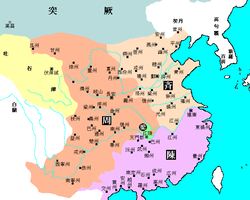Chen Dynasty
| Chen | ||||||||||
| 陳 | ||||||||||
|
||||||||||
| Capital | Jiankang | |||||||||
| Political structure | Empire | |||||||||
| Emperor | ||||||||||
| • | 557–559 | Emperor Wu of Chen | ||||||||
| • | 559–566 | Emperor Wen of Chen | ||||||||
| • | 566–568 | Emperor Fei of Chen | ||||||||
| • | 569–582 | Emperor Xuan of Chen | ||||||||
| • | 582–589 | Chen Shubao | ||||||||
| History | ||||||||||
| • | Established | 16 November 557 | ||||||||
| • | Disestablished | 10 February 589 | ||||||||
| • | Chen Shubao's death | 16 December 604 | ||||||||
|
||||||||||
| Today part of | ||||||||||
The Chen dynasty (simplified Chinese: 陈朝; traditional Chinese: 陳朝; pinyin: Chén Cháo; 557-589), also known as the Southern Chen dynasty, was the fourth and last of the Southern Dynasties in China, eventually destroyed by the Sui dynasty. Chen is the only dynasty named after the ruling house in Chinese history.
When the dynasty was founded by Emperor Wu, it was exceedingly weak, possessing only a small portion of the territory once held by its predecessor Liang dynasty—and that portion was devastated by wars that had doomed Liang. However, Emperor Wu's successors Emperor Wen and Emperor Xuan were capable rulers, and the state gradually solidified and strengthened, becoming roughly equal in power to rivals Northern Zhou and Northern Qi. After Northern Zhou destroyed Northern Qi in 577, Chen was cornered. To make matters worse, its final emperor Chen Shubao was an incompetent and indulgent ruler, and Chen was eventually destroyed by Northern Zhou's successor state Sui.
During the short-lived dynasty, the Chams to the south resumed raids against the region of Jiaozhi, perceiving the dynasty to be weak. The raids ended with the conquest of the Southern Chen by the Sui. The Sui general Yang Su suppressed various Chen rebels in campaigns during the early 590s.
...
Wikipedia

